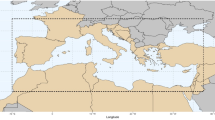Abstract
A common element in modelling forest fires and earthquakes is the need to develop space-time point process models that can be used to quantify the evolving risk from forest fires (or earthquakes) as a function of time, location, and background factors. This paper is intended as an introduction to space-time point process modelling. It includes brief summaries of the most relevant point process properties, starting from the description and estimation of first and second order moment properties, proceeding to a description of conditional intensity or dynamic models, and ending with an introduction to some of the models and estimation procedures which are currently being used in seismology. A short final section contrasts the modelling problems for seismology and for forest fires.
Similar content being viewed by others
References
Baddeley A, Turner R, Moller J, Hazelton M (2005) Residual analysis for spatial point processes (with discussion). J Roy Stat Soc (B) 617–666
Bebbington M, Harte D (2001) On the statistics of the linked stress-release model. In: Daley DJ (ed) Probability, statistics and seismology. J Appl Probab 38A:176–187
Brémaud P (1981) Point processes and queues: martingale dynamics. Springer, New York
Brillinger DR (1981) Time series: data analysis and theory, 2nd edn. Holden Day, San Francisco
Brownrigg R, Harte D (2005) Using R for statistical seismology. R News 5(1): 31–35
Chong FS (1983) Time-space-magnitude interdependence of upper crustal earthquakes in the main seismic region of New Zealand. New Zeal J Geol Geophys 26: 7–24
Cox DR, Isham V (1980) Point processes. Chapman and Hall, London
Daley DJ, Vere-Jones D (1988) Introduction to the theory of point processes; (2003) 2nd edn., vol I. Springer, New York etc
Diggle PJ (1983) Statistical analysis of spatial point patterns. Academic Press, London
Harte D (2004) PtProcess package: time dependent point process modelling. http://homepages.paradise.net.nz/david.harte/SSLib/Manuals/pp.pdf
Hawkes AG (1971) Point spectra of some self-exciting and mutually exciting point processes. Biometrika 58: 83–90
Lewis PAW, Shedler GS (1976) Simulation of non-homogeneous Poisson processes with log linear rate function. Biometrika 63: 501–506
Musmeci F, Vere-Jones D (1987) A variable grid algorithm for smoothing of clustered data. Biometrics 42: 483–494
Musmeci F, Vere-Jones D (1992) A space-time clustering model for historical earthquakes. Ann Inst Stat Math 44: 1–11
Ogata Y (1981) On Lewis’ simulation method for point processes. IEEE Trans Inform Theory IT-27: 23–31
Ogata Y (1988) Statistical models for earthquake occurrences and residual analysis for point processes. J Am Stat Assoc 83: 9–27
Ogata Y (1992) Detection of precursory quiescence before major earthquakes through a statistical model. J Geophys Res 97: 19845–19871
Ogata Y (1998) Space-time point-process models for earthquake occurrences. Ann Inst Stat Math 50: 379–402
Ogata Y (2004) Space-time model for regional seismicity and detection of crustal stress changes. J Geophys Res 109: B03308. doi:10.1029/2003JB002621
Ogata Y, Katsura K (1991) Maximum likelihood estimates of the fractal dimension for random spatial patterns. Biometrika 78: 463–474
Ogata Y, Katsura K, Tanemura M (2003) Modelling of heterogeneous space-time seismic activity and its residual analysis. Appl Stat 52: 499–509
Ogata Y, Zhuang J (2006) Space-time ETAS models and an improved extension. Tectonophysics 413: 13–23
Ripley BD (1981) Spatial statistics. Wiley, New York
Stoyan D, Kendall WS, Mecke J (1987) Stochastic geometry and its applications. Springer, Berlin
Stoyan D, Stoyan H (1994) Fractals, random shapes and point fields. Wiley, Chichester
Vere-Jones D (1978) Space time correlations for microearthquakes—a pilot study. Adv Appl Probab 10(Supplement): 73–87
Vere-Jones D (1979) Distributions of earthquakes in space and time. In: Moran PA (eds) Chance in nature. Australian Academy of Sciences, Canberra, pp 72–90
Vere-Jones D (1992) Statistical methods for the description and display of earthquake catalogs. In: Walden AT, Guttorp P (eds) Statistics in the environmental & earth sciences. Edward Arnold, London, pp 220–246
Vere-Jones D (1995) Forecasting earthquakes and earthquake risk. Int J Forecasting 11: 503–538
Vere-Jones D, Ben-Zion Y, Zuniga R (eds) (2005) Statistical Seismology, Pure Appl Geophys 162
Vere-Jones D, Daley DJ (2004) Scoring probability forecasts for point processes: entropy score and information gain. J Appl Probab 42: 297–312
Wheater HS, Isham V, Cox DR, Chandler RE, Kakou A, Oh L, Onof C, Rodroguez-Iturbe I (2000) Spatial-temporal rainfall fields: modelling and statistical aspects. Hydrol Earth Syst Sci 4: 581–601
Whittle P (1954) On spatial processes in the plane. Biometrika 41: 434–449
Whittle P (1962) Topographic correlation, power-law covariance functions, and diffusion. Biometrika 49: 305–314
Zheng X, Vere-Jones D (1994) Further applications of the stress release model to historical earthquakes. Tectonophysics 229: 101–121
Zhuang J (2006) Multidimensional second-order residual analysis of space-time point processes and its applications in modelling earthquake data. J Roy Stat Soc (B) 68: 634–653. doi:10.1111/j.1467-9868.2006.00559.x
Zhuang J, Ogata Y, Vere-Jones D (2004) Stochastic declustering of space-time earthquake occurrences. J Am Stat Assoc 97: 369–380
Zhuang J, Vere-Jones D, Guan H, Ogata Y, Li M (2005) Preliminary analysis of observations on the ultra-low frequency electric field in the Beijing region. Pure Appl Geophys 162: 1367–1396
Author information
Authors and Affiliations
Corresponding author
Rights and permissions
About this article
Cite this article
Vere-Jones, D. Some models and procedures for space-time point processes. Environ Ecol Stat 16, 173–195 (2009). https://doi.org/10.1007/s10651-007-0086-0
Received:
Revised:
Published:
Issue Date:
DOI: https://doi.org/10.1007/s10651-007-0086-0




